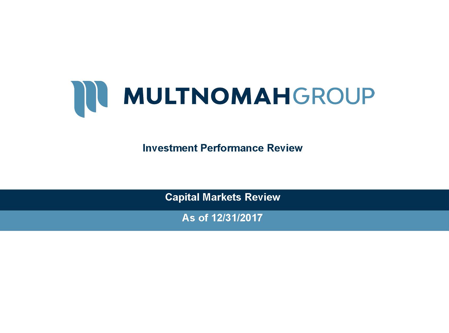 The U.S. economy grew at an annualized rate of 3.2% in the most recent quarter, the fastest pace in more than two years. The current economic expansion is the third longest in modern U.S. history at over 100 months long. While growth has not been robust throughout the cycle, it has been relatively steady. Tax reform will likely have a positive impact on the economic expansion in 2018.
The U.S. economy grew at an annualized rate of 3.2% in the most recent quarter, the fastest pace in more than two years. The current economic expansion is the third longest in modern U.S. history at over 100 months long. While growth has not been robust throughout the cycle, it has been relatively steady. Tax reform will likely have a positive impact on the economic expansion in 2018.
The labor market is solid with the unemployment rate holding steady at 4.1% in December, a 17-year low. 148,000 jobs were added in the month which was lower than expected due to retail sector job losses. Wage growth remained relatively low throughout 2017 despite the low unemployment rate. Core CPI, which strips out food and energy prices, rose 0.1% in November, up 1.7% from a year ago. This remains substantially below the 50-year average of 4.0%. The Federal Reserve’s preferred inflation measure, the personal consumption expenditures (PCE) price index excluding food and energy, has consistently undershot the Fed’s 2% target for over five years. U.S. factory activity increased more than expected in December, boosted by a surge in new order growth, signaling strong economic momentum. Consumer spending, which makes up over two-thirds of the U.S. economy, rose less than 1% for the most recent period. Consumer expectations remain at historically strong levels, despite a decline in consumer confidence in December after reaching a 17-year high in the prior month. Proposed tax cuts for an estimated 60% of households are expected to continue support robust consumption in 2018. The Fed raised interest rates by 25 basis points in December; the recent hike was the fifth increase since December 2015. A new Fed led by Jerome Powell with other appointments by President Trump will likely make for a more “hawkish” approach to monetary policy in 2018 – thus one could reasonably expect stronger actions from the Fed regarding the number and magnitude of rate hikes given the threat of inflation. 10- and 30-year Treasury bond yields increased modestly to 2.4% and 2.7% during the quarter. All fixed income sectors had positive returns for the quarter except for asset-backed securities that reported a minuscule loss. The dollar index moved modestly lower in the quarter. The Fed started reducing its bond holdings in late 2017 and will continue at a measured pace over the course of several years; this follows the expansion of its balance sheet since late 2008 as it staved off a collapse of the financial system.
The U.S. equity markets continued to soar with the S&P 500 gaining 6.6% for the quarter and 21.8% for 2017. The recent strength was partly due to upcoming tax reform - the first significant reform of the U.S. tax code since 1986. The equity markets also responded to continued attractive earnings for S&P 500 companies which should continue into 2018. The largest sector gains in the S&P 500 for the quarter were consumer discretionary and technology, increasing 9.9% and 9.0%, respectively. For the year, tech stocks led the way, increasing 39%. All sectors were in positive territory for the quarter. The forward P/E for the S&P 500 inched up to 18.2x, versus a 25-year average of 16.0x. Large cap stocks outperformed small caps for the quarter and the year. The emerging markets sector continued to rally in the fourth quarter finishing the year up 38% taking advantage of a broad-based world economic expansion and favorable commodity prices. China continued to climb higher increasing nearly 8% for the recent quarter and 54% for the year. Commodities showed signs of life late in 2017 as the Bloomberg Commodity Index gained over 4% during the fourth quarter, but ended 2017 as the second worst performing asset class. U.S. crude oil prices jumped about 16% in the quarter, finishing just shy of $60/barrel. REITs gained 2.6% for the quarter and about 9% for the year. Fundamentals remained strong for commercial real estate with positive rent growth and stable vacancy rates across nearly all core property types. Residential home prices continued to rise during the quarter based on low supply and high demand.
To view Multnomah Group's full Capital Markets Review, please click here.
Multnomah Group is a registered investment adviser, registered with the Securities and Exchange Commission. Any information contained herein or on Multnomah Group’s website is provided for educational purposes only and does not intend to make an offer or solicitation for the sale or purchase of any specific securities, investments, or investment strategies. Investments involve risk and, unless otherwise stated, are not guaranteed. Multnomah Group does not provide legal or tax advice.
Any views expressed herein are those of the author(s) and not necessarily those of Multnomah Group or Multnomah Group’s clients.

